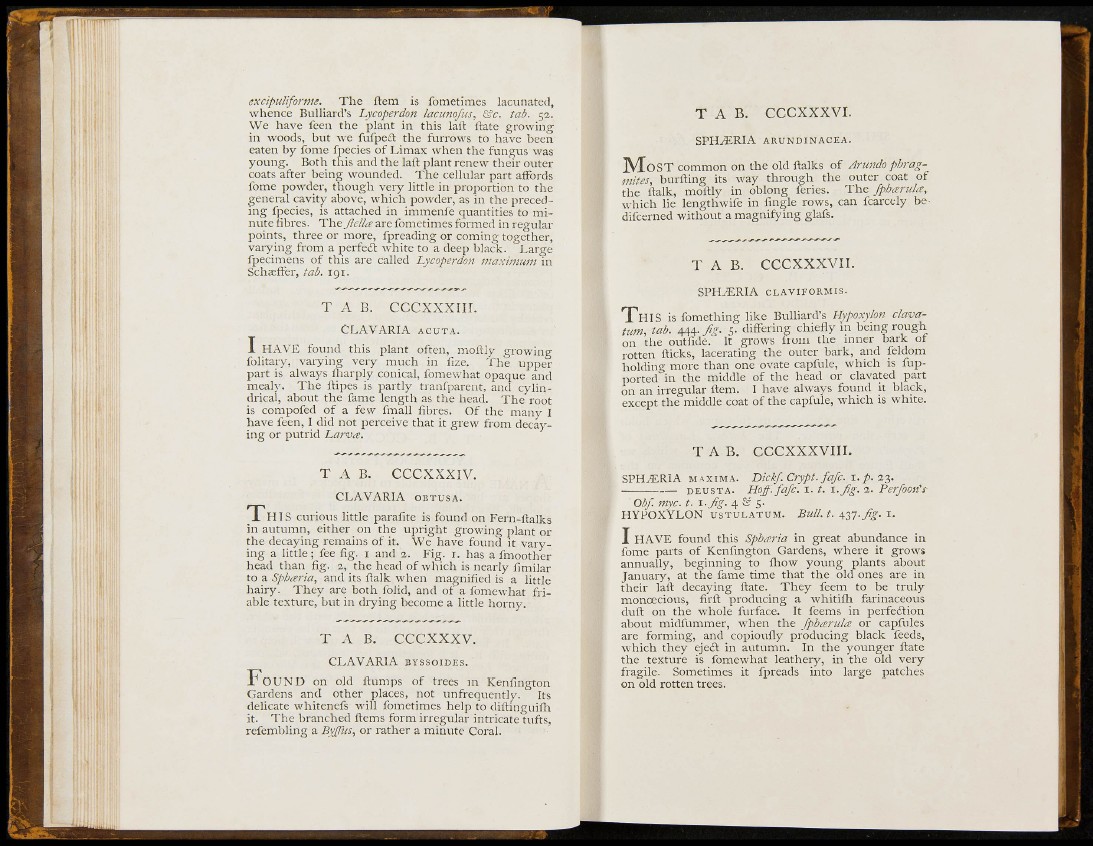
excipuliforme. The ftem is fometimes lacunated,
whence Bulliard's Lycoperdon lacunojus. &c. tab. 52.
We have feen the plant in this laft ftate growing
in woods, but we fufpea the furrows to have been
eaten by feme fpecies of Limax when the fungus was
young. Both this and the laft plant renew their outer
coats after being wounded. The cellular part affords
fome powder, though very little in proportion to the
general cavity above, which powder, as in the preceding
fjiecies, is attached in immenfe quantities to minute
fibres. TheyFe/ZiC are fometimes formed in regular
points, three or more, fpreading or coming together,
varying from a perfeft white to a deep black. Large
fpecimens of this are called Lycoperdon maximu7n in
Schajfler, tab. 191.
T A B. cccxxxni.
CLAVARIA ACUTA.
this plant often, moftly growing
very much in fize. The upper
I HAVE found
folitary, varying
part is always fliarply conical, fomewhat opaque'and
mealy. The ñipes is partly tranfparent, and cylindrical,
about the fame length as the head. The root
is compofed of a few fmall fibres. Of the manv I
have feen, I did not perceive that it grew from decaying
or putrid Larva.
T A B. CCCXXXIV.
C L A V A R I A OBTUSA.
T H 1S curious little parafite is found on Fern-ftalks
in autumn, either on the upright growing plant or
the decaying remains of it. We have found it varying
a little; fee fig. i and 1. Fig. r. has a fmoother
head than fig. 2, the head of which is nearly fimilar
to a Spharia, and its flalk when magnified is a little
hairy. They are both folid, and of a fomewhat friable
texture, but in drying become a little horny.
T A B. CCCXXXV.
CLAVARIA BYssoiDEs.
F O U N D on old flumps of trees m Kenfington
Gardens and other places, not unfrequently. Its
dehcate whitenefs will fometimes help to diftinguifli
it. The branched flems form irregular intricate tufts,
refembling a ByJTus, or rather a minute Coral.
T A B . CCCXXXVI.
SPHTERIA ARUNDINACEA.
M O S T common on the old ftalks of drundophragmites,
burfting its way through the outer coat oi
the italk, moftly in oblong feries. The fpharulce,
which lie lengthwife in fingie rows, can fcarcely bedifcerned
without a magnifying glafs.
T A B. CCCXXXVII.
S P H A R I A CLAVIFORMIS.
T H I S is fomething like Bulhard's Hypoxylon clavatum,
tab. 444./á'. 5. differing chiefly in bemg rough
on the outfide. It grows from the inner bark of
rotten flicks, lacerating the outer bark, and feldom
holding more than one ovate capfule, which is fupported
in the middle of the head or clavated part
on an irregular ftem. I have always found it black,
except the middle coat of the capfule, which is white.
T A B . CCCXXXVIII.
SPHARIA MAXIMA. Bickf.Crypt.fafc. i.p.%?,.
DEUSTA. Hoff-iafc. I. t. x.fig. 1. Perfoon's
Obf. myc. t- i-Jig. 4 5i SHYPOXYLON
USTULATUM. Bull. t. AoT-fS- i-
I HAVE found this Spharia in great abundance in
fome parts of Kenfington Gardens, where it grows
annually, beginning to fliow young plants about
January, at the fame time that the old ones are in
their laft decaying ftate. They feem to be truly
moncecious, firfl producing a whitifh farinaceous
duft on the whole furface. It feems in perfeilion
about midfummer, when the fpbarula or capfules
are forming, and copioufly producing black feeds,
which they ejeit in autumn. In the younger ftate
the texture is fomewhat leathery, in the old very
fragile. Sometimes it fpreads into large patches
on old rotten trees.